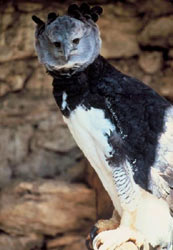

The Harpy Eagle is the most powerful eagle of the humid Neotropical forests. Its is under threat because of forest loss and persecution from humans. These magnificent eagles only reproduce slowly in the wild with one chick every two to three years, so to expect any increase in their numbers from breeding in the wild will take a long time. Early South American explorers named the bird "harpy" eagle after the predatory half-woman, half-bird monster of Greek mythology.
The Harpia harpyja (its latin name) weighs from 5-8 Kg. (male) and 7-9 Kg. (female) and has a wingspan of 7 feet (around 2.16 metres). Its head is pale grey and crowned with a double crest. The back of the animal is black and its underside is white with a black stripe or band going up the chest thus giving it a menacing look to match its reputation. This is one of the largest of the 50 species of eagles and can reach a speed of around 50 mph.
Peregrine Fund has a breeding program for breeding in captivity, then releasing the offspring into the wild. Some 30 Harpy Eagles have been released in Soberania National Park, Panama, and Chiquibul Forest, Belize, since 1998. All of these eagles have adapted well to the wild and have been seen to catch prey including monkeys, kinkajous, coatimundis, and porcupines.This captive breeding program ended in 2006. They employ nine Embera and Wounaan technicians who participate in daily data collection and tracking devices to follow the birds movements. Research has shown that Harpy Eagles can inhabit places where up to 30% of the forest has been lost due to human cultivation. Previously, it had been thought that eagles were an indicator of continuous intact primary forest.